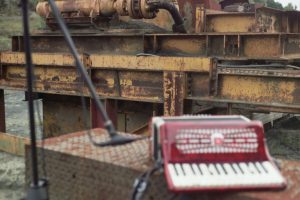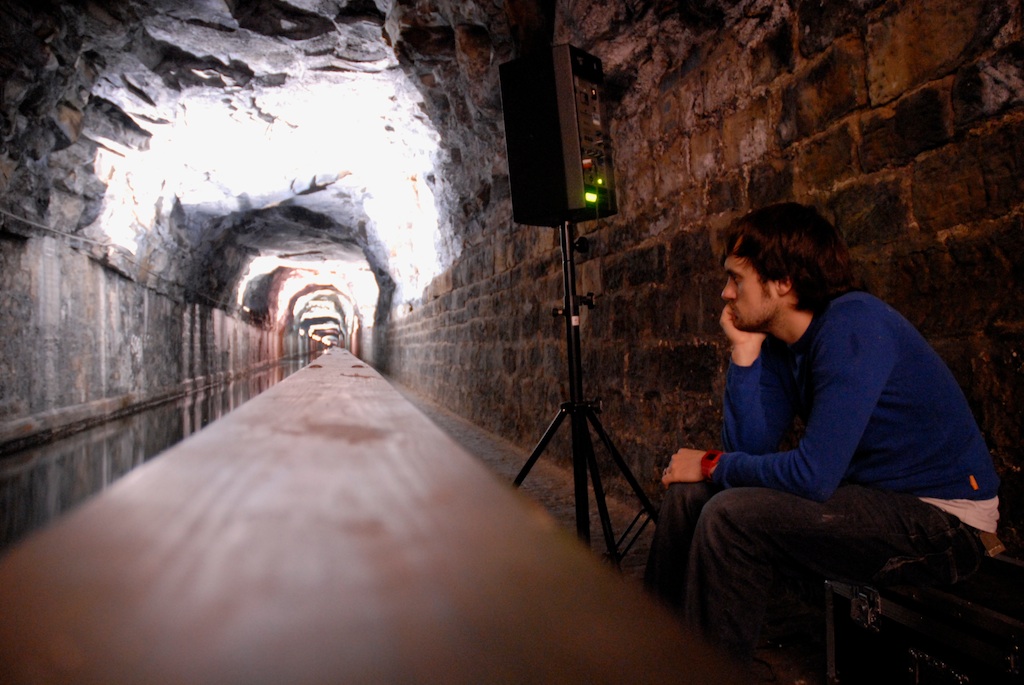Guest Contribution by Dan Lyth
 The story of the ‘bedroom producer’ recording music at home has been told often and I myself have happily been that character for many years. But recently, a love of field recording (and my day job as a sound designer) tempted me towards doing something a bit different. What would it be like to leave the studio and record an entire album outdoors? What happens when you attempt to perform and record music in such uncontrollable environments? And would it be possible to weave together the unpredictable sounds of these environments with more traditional performances to create a cohesive whole? I found these questions fascinating. I have also always been drawn to creative work that has taken a considerable amount of effort and recording an album outdoors whilst living in Scotland with its devious climate seemed to fit the bill…
The story of the ‘bedroom producer’ recording music at home has been told often and I myself have happily been that character for many years. But recently, a love of field recording (and my day job as a sound designer) tempted me towards doing something a bit different. What would it be like to leave the studio and record an entire album outdoors? What happens when you attempt to perform and record music in such uncontrollable environments? And would it be possible to weave together the unpredictable sounds of these environments with more traditional performances to create a cohesive whole? I found these questions fascinating. I have also always been drawn to creative work that has taken a considerable amount of effort and recording an album outdoors whilst living in Scotland with its devious climate seemed to fit the bill…
Fairly quickly I settled for the approach of combining traditional stereo field recordings with close miked instrument recordings. I had a couple of fairly cheap omni-directional microphones, a stereo pre-amp, a Sony PCM D-50 and a homemade Jecklin disc. And that’s about it. But as Randy Thom mentioned in his recent post, “Recording… should mostly be about finding good sounds to record, not about the equipment you use”.
And there are certainly some good sounds out there. Some very moving sounds too.
I’ll never forget listening to wounded earthquake survivors singing together to lift their spirits at a field hospital in Haiti. Or the evening call to prayer resounding around the city from the mosques in Fes, Morocco. I’ll never forget the thunderous crowd at a bullfight in rural southern Spain. Or the waves crashing on an isolated Turkish beach while turtles crawled up the shore to lay their eggs. A flamenco dancer’s feet playing rhythms on the concrete in Seville or the savannah coming to life at dawn in a Ugandan National Park.
 But it wasn’t all this romantic. It’s quite hard work transporting a drum kit to a remote derelict church or dragging a piano out of a small flat. There were a lot of locations that looked great on paper but turned out to be unusable. There were broken mic stands, bleeding fingers and failing batteries. And there was a lot of rain. On one particular occasion we had spent several hours setting up a full band recording when it promptly starting raining before we’d even begun the first take. Thankfully our hosts at the house where we were based were very resourceful and fifteen minutes later with the help of a Land Rover and a large sail, we were able to proceed.
But it wasn’t all this romantic. It’s quite hard work transporting a drum kit to a remote derelict church or dragging a piano out of a small flat. There were a lot of locations that looked great on paper but turned out to be unusable. There were broken mic stands, bleeding fingers and failing batteries. And there was a lot of rain. On one particular occasion we had spent several hours setting up a full band recording when it promptly starting raining before we’d even begun the first take. Thankfully our hosts at the house where we were based were very resourceful and fifteen minutes later with the help of a Land Rover and a large sail, we were able to proceed.
 It was fun too. It was fun recording double bass in a park while Japanese tourists took photos. It was fun sneaking out of a fire exit in Abbey Road studios before being stopped by a security guard (recording inside that famous space would have certainly been breaking the rules of this project!). And recording vocals in a local forest while deer stood a few metres away and observed was certainly a novel experience.
It was fun too. It was fun recording double bass in a park while Japanese tourists took photos. It was fun sneaking out of a fire exit in Abbey Road studios before being stopped by a security guard (recording inside that famous space would have certainly been breaking the rules of this project!). And recording vocals in a local forest while deer stood a few metres away and observed was certainly a novel experience.
One of the final challenges was creating and capturing reverb. After all this outdoor recording the thought of using digital reverb on the tracks that needed them didn’t sit well at all. And so the search began for the perfect outdoor reverb chamber. After several fruitless visits to local caves I started exploring canal tunnels and eventually found one that is over 600 metres long and has a lovely sound. No unpleasant flutter echoes and an ideal decay time of around three to four seconds. Satisfied, a friend and I then spent an eerie night re-recording some of the parts being played loudly through a speaker. It was cold, pitch black and sounded incredibly haunting. We just hoped the police wouldn’t turn up.
After travelling, listening, recording and being constantly surprised over the course of four years and across four continents, it was pretty much done. And what will really stay with me is not only all the wonderful sounds we heard but also the many inquisitive, open-minded and generous people we met along the way. Whatever area of field recording you’re interested in, as the post for this month’s theme encourages, get out and record! The world is full of fascinating sounds and fascinating people.
For those of you interested, the omni mics that I mention are Brad Avenson’s STO-2’s and the pre-amp is a Naiant Littlebox from Jon O’Neil. The STO-2’s sound great although I have to say they are a little noisy on quieter sources. The pre-amp is also excellent and with the lithium ion battery option, you get hours of full, clean phantom power.
Many of the words we might use in describing why a recording doesn’t sound quite right — murky, muddy, muffled, bright, tinny, crisp, harsh, nasal, boxy — describe EQ problems. Part of my goal in EQ is to avoid all these problem qualities, and make the recording sound like the piano sounds in real life — or in my imagination.
That’s what I aim to do too–try to capture how I think it sounds or how I think it should sound–unless I’m trying to experiment with different sounds/techniques.
Very cool video, I have been field recording sounds to make music recently–so this is inspiring to me!
Looks and sounds really great!!! Nice and inspiring :)
A really interesting video! Would be great to put some Trombone if it’s something you’re interested in.